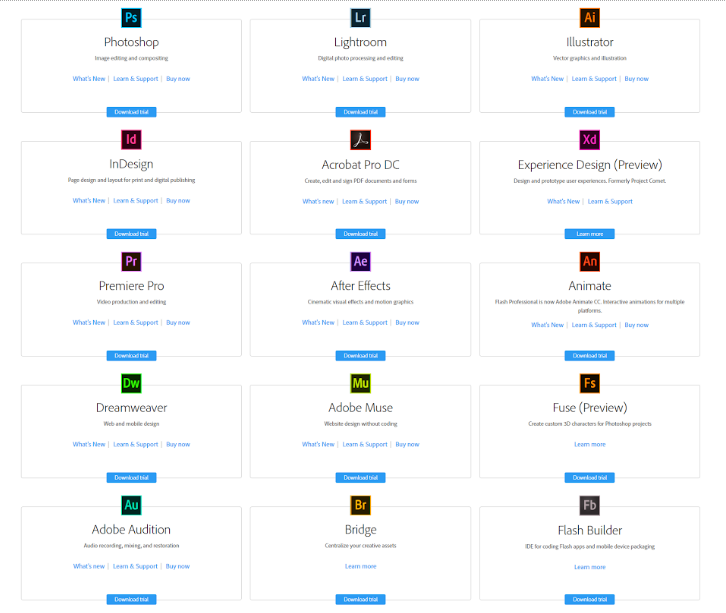
Subscribe to our newsletter!
We don't spam. You will only receive relevant and important tips for you and your business.
Unsubscribe anytime.
By Ryan Boog
In the 2000s, I was a college student in MN. My degree track was Visual Communications Technologies with an emphasis on multimedia. This is when my web design skills were known as “Adobe web design” skills. I was in a website creation course when I heard this phrase:
"Your next course will be in Flash. Flash is the future of the web. It is here to stay, and it can do so much."
Even better, I was able to get my hands on Dreamweaver. I was able to design my mockups in Photoshop, code them in Dreamweaver, and add fun stuff with Flash. By 2006, I was what I call "Adobe reliant".

 A prominent change for Adobe was the schizophrenic life around the Adobe product Flash. Animators revered it. Heck, it even taught them how to code. Flash utilizes a coding language called ActionScript. It has similarities to many programming languages. Anyone proficient in ActionScript has a good chance of getting a programming job.
A prominent change for Adobe was the schizophrenic life around the Adobe product Flash. Animators revered it. Heck, it even taught them how to code. Flash utilizes a coding language called ActionScript. It has similarities to many programming languages. Anyone proficient in ActionScript has a good chance of getting a programming job.
My agency hired a developer who was an expert in ActionScript. His skill set translated to PHP and Jquery in a stupendous manner. But he still mutters "Apple killed Flash" to this day.
What does he mean by that? This gets back to the schizophrenic part. While Flash was growing and doing cool things, it had its opponents. The most notable critic was Steve Jobs.
Jobs loathed Flash. He once said, "Flash is a spaghetti-ball piece of technology that has lousy performance and a really bad security problem."
Jobs had done a great job growing Apple into a huge slice of tech market share. To the chagrin of a few people, he refused to support Flash. He was so steadfast with his direction on this that it left many websites not viewable on any Apple device.
This lead to the demise of Flash. To answer my developer's question, "Yes. Steve Jobs killed Flash". CNN agreed in 2011. If you Google "death of flash" you'll find gobs of information about Flash officially dying.
IDE stands for, "Integrated Development Environment". The most common function of an IDE is writing code. When I started my agency, I noticed a slip in market share with Adobe's popular IDE, Dreamweaver. So much so that I read posts declaring that Dreamweaver is dying.
I was one of those statistics. I used Dreamweaver for years. For me, in the end, it was too clunky, had way too many options and it made the simplest tasks seem difficult. To this day, our office has developers that only code on Sublime Text 3 and PHP Storm.
In 2013, we ditched Photoshop and Adobe. As the web evolved, especially with mobile, a static image editor didn't cut it anymore. We graduated to designing in responsive prototypes. Today, we design with code.
We went from "Adobe reliant" to "Adobe free". That word, "free", has a couple of meanings here. I'm not going to lie, the fact that we didn't have to pay for licensing each year was very nice.
To this day, we are still Adobe free.
 The answer is no. Let's dissect this, though, as it's not that simple.
The answer is no. Let's dissect this, though, as it's not that simple.
Has it declined? Without a doubt, it has declined. Look at the market share. In the mid-2000s, it had over 40% market share of websites.
That means a ton of websites were developed with Dreamweaver. Now, only a remnant of that remains. Today that market share has dropped to 0.7% according to Built With.
Enter Muse. (not the band)
For a monthly payment of \$14.95, you can use Adobe's latest tool for creating code. The angle: you don't need to know how to write code. The tool is called Muse.
Why do I think Muse will have some success? It's the nature of a lot of freelancers and beginner level web designers today. They're used to getting Wordpress and plopping on a template. They're used to installing plugins and widgets.
Need a landing page? Just use a generator like Unbounce or LeadPages. I know many "developers" that can't code that well or at all. People rely on something to do the work for them and Muse is a perfect asset for those people.
One thing I have to credit Adobe with is that it works to enhance its products. It tries to stay current. It tries to listen to its users. I noticed this when I was Adobe reliant.
Dreamweaver today has a focus on mobile. They needed to do this. The web is mobile, and desktop is almost the exception.
Adobe ties in its product for imagery (Adobe Stock) with Dreamweaver. That is huge as well. That leads into what they do well as a brand.
They have all their apps that you need for web development on the cloud. These cloud-based apps make it easy for you to get integrated with their brand. When you get the Creative Cloud package for \$50 per month, you get a ton of software with it.
Instead of 2 or 3 pieces of software, Adobe has software for many specific Adobe web design needs.
In fact, that is a ton. But, what I like the best about this move from Adobe, is that they still make this affordable for students. They always have provided steep discounts for students, and that hasn't changed. Kudos to you, Adobe.
Even though each application has their similarities, they are different in one key area. They cater to different segments.
Muse is a less-technical, consumer level software for individuals who have little to no coding experience. With Muse you can create fixed, fluid, and adaptive websites without having to write any code. It's drag-and-drop functionality gives users the ability to host their site with any hosting provider.
With Dreamweaver, on the other hand, you need to code it out. This professional level software is for developers of enterprise level web sites who want to hand-code the websites they create. If you are comfortable writing HTML/CSS/JS, then Dreamweaver is the tool for you.
These are very different products that are made for very different markets. Both are created by Adobe and both produce websites, but know your skill set before picking one of these tools to design a website.
Because Dreamweaver is for the programmers and code junkies, for the most part, it will create a better code than Muse. Muse has a tendency to create more code than necessary, but it was never designed to create better code. Muse has better design tools. And for the quickest way to design something, Muse is the tool to use.
Website responsiveness is a key consideration as you will want to check and see how your site works on different devices. With Dreamweaver the responsive feature is not a problem. Muse will allow a single option to select a responsive or adaptive design based on your project needs. To accommodate a wide range of screen sizes, responsive design is the way to go. But in a few cases, you may want to stick with an adaptive design.
Not in the least. Will we use it? No, we won't. But Adobe has its place among the web design community and I see that for years to come. It may not have as large of a market share as it once did, but it provides value to the web community.